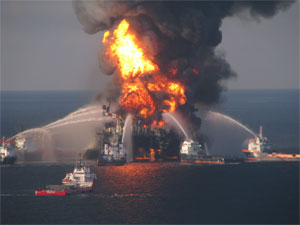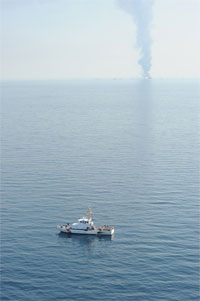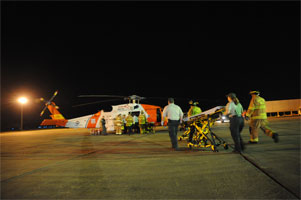The U.S. Coast Guard's preliminary report on the Deepwater Horizon disaster signals possible reforms to maritime-oriented regulations governing Gulf of Mexico oil activity.
In addition to several serious problems related to drilling and rig-operation safety, the April 2011 report identified weaknesses in rules related to flag-state oversight, dual-command structures on rigs and equipment needed in a water rescue.
 |
|
Response crews fight the fire on the remnants of Deepwater Horizon. The rig exploded and sank in April 2010. Eleven of the 126 crewmembers aboard the rig were killed and 16 were injured. (Photo courtesy U.S. Coast Guard) |
The investigative report was written in conjunction with the Bureau of Ocean Energy Management, Regulation and Enforcement, formerly the Minerals Management Service. Its findings are preliminary. A final report is due this summer.
On April 20, 2010, the Mobile Offshore Drilling Unit (MODU) Deepwater Horizon exploded and sank 40 miles south of Louisiana. Eleven of the 126 crew were killed and 16 were injured. The blast resulted in the largest marine oil spill in U.S. history.
Deepwater Horizon was registered in the Republic of the Marshall Islands (RMI). In the investigative report, the Coast Guard found that the Marshall Islands flag authority failed to oversee the safety of the rig sufficiently and was "ineffective in preventing this casualty."
The report criticizes the Marshall Islands for not directly checking that Deepwater Horizon had complied with requirements governing electrical equipment, watertight integrity, crew training and emergency preparedness. Instead, the flag state hired the American Bureau of Shipping and Det Norske Veritas and failed to monitor the work of those classification societies.
"The RMI effectively abdicated its vessel inspection responsibilities," the report said. “In turn, this failure illustrates the need to strengthen the system of U.S. Coast Guard oversight of foreign-flagged MODUs, which as currently constructed is too limited to effectively ensure the safety of such vessels."
U.S. and international maritime labor groups applauded that preliminary finding. Seafarers International Union Secretary-Treasurer David Heindel said flags of convenience are a barrier to compliance with safety-management systems and other standards.
 |
|
The Coast Guard Cutter Pompano, an 87-foot patrol boat, searches for survivors from Deepwater Horizon. The Coast Guard's initial report on the disaster faulted the dual-command structure on the rig, saying it may have slowed decision-making. (Photo courtesy U.S. Coast Guard) |
"When rules and regulations are or become lax, conditions can deteriorate into confusion and chaos," Heindel said. "This was seen aboard the Deepwater Horizon. … It was not registered in the United States, which has a rich maritime history, but instead with the Marshall Islands, which lacks a strong regulatory regime."
The Marshall Islands registry defended itself by stating that the report blurs the distinction between facts that were actual causes of the Deepwater Horizon disaster and mere observations that spur discussion of future safety improvements. It said the United States also uses classification societies to handle some compliance tasks.
Marshall Islands-flagged vessels are subject to oversight that is very similar to the U.S. Coast Guard's highly touted Alternative Compliance Program. Deepwater Horizon underwent inspections by both the Coast Guard and Minerals Management Service and earned its two-year certificate in July 2009.
"Neither agency reported safety deficiencies or issues of concern as a result of these inspections," the Marshall Islands maritime administrator's office said in a statement. "At the time of the casualty, the Deepwater Horizon was certified in accordance with all existing U.S., RMI and international requirements."
The Coast Guard faulted the flag state for indirectly enabling an ambiguous chain-of-command framework aboard Deepwater Horizon. Sometimes the master was in charge; at other times the offshore installation manager (OIM) was. This murkiness may have caused a delay in activating the emergency disconnect system (EDS) early in the emergency.
"The Marshall Islands" "clerical error" in listing Deepwater Horizon as a self-propelled MODU instead of a dynamic positioned vessel enabled Transocean to implement a dual-command organizational structure on board the vessel," the report said.
"The OIM was in charge when the vessel was latched on to the well, but the master was in charge when the MODU was underway between locations or in an emergency situation," the report said.
"When the explosions began, however, there was no immediate transfer of authority from the OIM to the master, and the master asked permission from the OIM to activate the vessel's EDS," it said. "This command confusion at a critical point in the emergency may have impacted the decision to activate the EDS."
The joint investigative team recommended that the Coast Guard "pursue regulatory changes to provide clear designation of the person in charge under both operating and emergency conditions for all MODUs operating on the U.S. Outer Continental Shelf."
 |
|
Emergency workers rush a gurney to a Coast Guard HH-60 rescue helicopter and crew from Coast Guard Aviation Training Center Mobile, Ala., at Coast Guard Air Station New Orleans. The helicopter evacuated injured survivors from Deepwater Horizon after an explosion and fire forced the crew of the vessel to abandon the rig. (Photo courtesy U.S. Coast Guard) |
The report mentioned the possibility of requiring MODUs to have a fast rescue craft. Gulf rigs already have lifeboats, which sometimes can function as rescue vessels. In the Deepwater Horizon response, a fast rescue boat from the nearby platform supply vessel Damon B Bankston was credited with saving lives.
"The evacuation of Deepwater Horizon was substantially aided by the presence of the Damon B Bankston and the use of its "fast rescue craft," which assisted at least 15 survivors," the Coast Guard wrote. "Although there is no regulatory requirement for a MODU to have a "standby vessel" at its side for safety purposes or to have its own fast rescue craft, the role of the Damon B Bankston played in saving lives demonstrates the value that such requirements could provide."
That rescue craft was a Schat-Harding MOB17 with a 40-hp outboard engine, said Bart Reynolds, area manager with the Bankston operator Tidewater Marine.
"We were able to launch it and put it in the water with the engine already running," Reynolds said. "It certainly did the job for us. It was fast enough to get out of the way of the fire and not get anyone injured or burned."
The rescue craft has an even better engine on it now, Reynolds said. "We had a 40-hp motor on that, and we recently replaced it with a 60-hp motor," he said. "We never found that having the extra power is a negative."
Reynolds said the Bankston's launch is only about 15 feet above the water. A rig can be 100 feet, so launching a fast rescue craft or keeping it on standby somewhere may be trickier.
